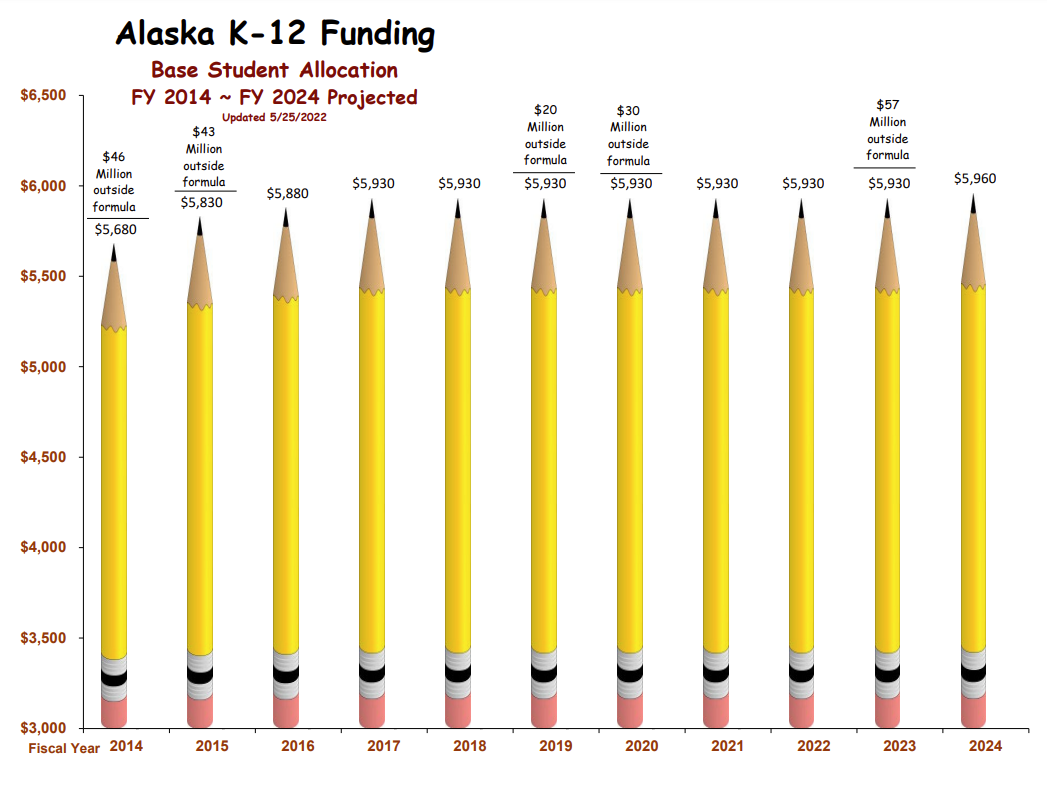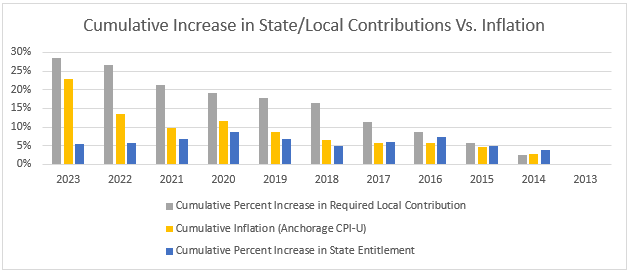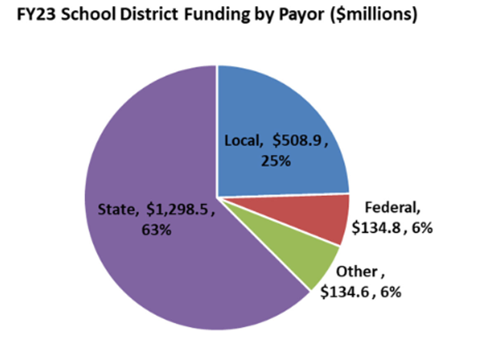There’s been a lot of debate the past few months about the level at which Alaska funds education. On one side, that of many educators and parents, the rallying cry is that the Base Student Allocation (BSA) has not kept up with inflation. This is true, and the Department of Education and Early Development has a professional looking bar chart to prove it.

There’s an interesting dynamic in Alaska’s K-12 formula. In essence, the first dollar contributed is the required local contribution (and in some cases Federal Impact Aid in lieu of local contributions) with the state contributing what is left to fund up to the BSA times an adjusted student count. Prior to 2013, the required local contribution to education was an assessment of 4.0 mills on local property. Due to high oil prices, that rate was reduced to 2.65 mills. This should have provided relief to communities. However, in the decade since this change, property values have grown in excess of inflation, driving the local contribution higher and higher while state contributions have stagnated.
Overall, since 2013, inflation totaled 23% while the required local contribution increased 29%. The state entitlement grew by just 5.4% over this same time period. If state funding had grown at the same pace as local contributions, spending would have been more than $250 million higher today.

On the other side are many fiscal conservatives who point out that Alaska spends more than our peer states, yet the outcomes appear lackluster. They advocate for non-financial solutions and more accountability to be placed on the school districts. The state does contribute a large proportion of the total K-12 funding, 63% according to the Legislative Finance Division, while most other states contribute around 50%. However, the size of the pie, when considering all funding sources, has not adequately grown to reflect increasing cost drivers in the economy.

Adequately funding education, or any core government service, is something that Alaska has struggled with for decades. And it all comes down to the state’s revenue volatility. Most things in the economy track with time. As the cost of living increases the average retail sale amount increases, the average income increases, and property values increase. So, states that depend on broad-based sales or income tax measures will see “automatic” increases to their budgets as the proceeds of those taxes grow to match the increasing cost in the level of goods and services in the economy. Alaska does not benefit from these trends due to reliance on a single volatile commodity: oil. This has led to a funding struggle for major budget items such as the Permanent Fund Dividend, K-12, and the University of Alaska.
Several well-intentioned bills, focusing on an increase to the BSA, were introduced during the 2023 legislative session, but they all miss the mark by narrowly focusing on increasing the BSA without revisiting the multiple escalators in the funding formula itself. A BSA increase would provide relief to districts, but the problem is more complex than increasing a single factor in the state’s convoluted K-12 formula. Absent a complete overhaul of the K-12 formula, there would be winning and losing districts, and the additional funds may not be targeted where they are most needed.
The last major overhaul of education was done in tandem with community assistance and pension reform. The intent was to ensure there would be no fiscal “losers” when all three reforms were implemented. For example, Anchorage had been studious in paying down their pension obligations; but other cities had not. This resulted in Anchorage having to pay for more for retirement costs. As part of this compromise, Anchorage, having more intensive students, was given a 13X multiple on those students in the K-12 formula. While this mechanism was beneficial in getting to “yes” in the Legislature, it may or may not be serving the state well.
There’s considerable concern over Governor Mike Dunleavy’s (R – Alaska) veto of half of the $175 million one-time increase to K-12. But even without a veto, those funds were temporary and only a band-aid solution. Rather than spending time attempting to override Dunleavy’s veto, the Legislature should instead look into each factor in the school formula to determine if it is actually meeting Alaska’s needs. Are the district cost escalators still accurate (last revised in 2008)? Is the cap on local contributions to education hindering outcomes? Is correspondence student funding still adequate now that more students are participating in post-pandemic online classes?
There are many questions to address, and solving the state’s education problems will take more work than increasing a single number. The Legislature should establish a working group to investigate what is and is not working in the formula rather than simply increasing the program across the board.
Brian Fechter has held several public policy positions for the State of Alaska, most recently as deputy commissioner for the Department of Revenue.






It’s too bad the bureau of Indian education doesn’t have allocated funding to help the school systems here in Alaska. The native kids could use assistance to get their education more in line with the ones that do receive the funding.
Uh. Education funding debates often reflect Alaska’s unique challenges, encompassing various perspectives on addressing the Base Student Allocation and financial accountability within school districts. Brian Fechter provides a comprehensive analysis, urging a closer examination of multiple factors in the funding formula. For more insights on academic challenges and writing help, click this resource https://www.topessaywriting.org/. This platform assists students in meeting deadlines, improving writing skills, and understanding complex topics through professionally crafted content.